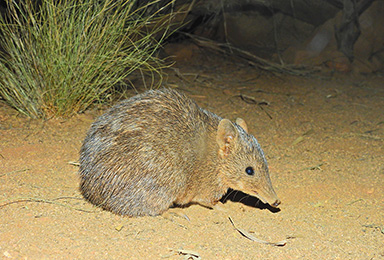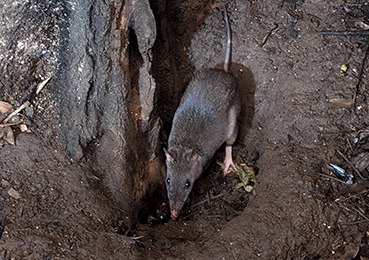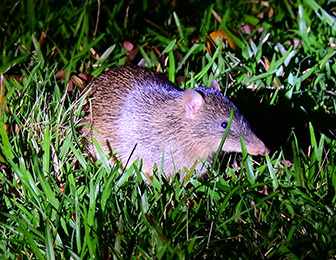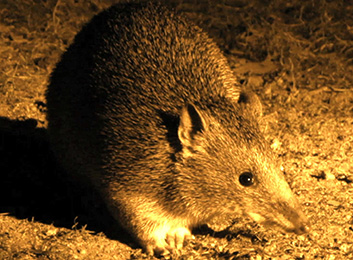BANDICOOTS
Bandicoots: Australia’s Small but Mighty Marsupials
Bandicoots are one of Australia’s lesser-known native marsupials, yet they are remarkable in both their biology and their role in the environment. Belonging to the order Peramelemorphia and the family Peramelidae, they are found in various habitats across Australia and parts of Papua New Guinea.
Physical Characteristics
Bandicoots are small to medium-sized animals, usually weighing between 150 grams and 1.5 kilograms, depending on the species. Their most recognisable features include:
- Long, pointed snout – perfect for probing the soil and leaf litter for food.
- Small rounded ears – excellent for detecting the faint sounds of insects and other prey.
- Compact, rounded body – ideal for moving quickly through dense vegetation.
- Short tail – aiding balance as they dart about.
Their fur ranges from grey-brown to reddish, often blending seamlessly with their surroundings.
Behaviour and Diet
Bandicoots are nocturnal – most active at night – and spend daylight hours resting in concealed nests. They are omnivores, feeding on:
- Insects (such as beetles, larvae, termites)
- Earthworms
- Fungi
- Roots and tubers
- Small vertebrates (occasionally)
They forage by digging cone-shaped holes in the ground. While some gardeners may find these holes unsightly, they are actually beneficial, as bandicoots help control pests and improve soil health through natural aeration.
Habitat
Different species of bandicoots live in a variety of landscapes, including:
- Woodlands and forests
- Heathlands
- Grasslands
- Semi-arid scrub
- Suburban bushland edges
They build above-ground nests from grasses and leaves, often under shrubs or logs, and sometimes use hollow logs as shelter.
Reproduction
Bandicoots have one of the shortest gestation periods of any mammal – just 12½ days. The tiny newborns, barely 13 mm long and weighing around 2.5 grams, crawl into the mother’s backward-facing pouch, where they continue to develop.
- Young stay in the pouch for about 60 days.
- They become independent at around 4 months of age.
The backward pouch prevents dirt from entering when the mother digs for food, a clever adaptation for a digging animal.
Conservation and Coexistence
To help protect bandicoots:
- Preserve natural habitats and old trees with hollows.
- Keep cats indoors at night and manage dogs responsibly.
- Watch for wildlife when driving at night.
- Support local wildlife rescue organisations.
Why Bandicoots matter
- Bandicoots are natural gardeners. Their thousands of small diggings each year aerate soil, reduce fuel loads, and help native plants regenerate.
- They are adaptable, living in tropical savannas, woodlands, coastal heaths and even leafy suburbs—if we make room for them.
What puts them at risk
- Predation by introduced animals such as foxes, cats, and dogs.
- Competition with introduced species for food and shelter.
- Loss of habitat from land clearing and urban expansion.
- Loss of dense ground cover and understorey, including from high-intensity, broad-scale burns
- Habitat fragmentation (fences and roads that cut off safe movement)
- Poisoning from rodenticides and some snail baits
- Vehicle strikes at dusk and dawn
What you can do
1) Make your garden bandicoot‑friendly
- Plant layers: dense native shrubs and tussock grasses (e.g., lomandra, native grasses, tea-trees, grevilleas) to provide low cover for nesting and foraging.
- Keep a “wild corner”: leave leaf litter, mulch and fallen branches—ideal nesting material and rich in insects.
- Water and shelter: a shallow water dish with a stick or stones for easy exit; brush piles or log stacks for hideaways.
- Fencing for wildlife: where safe, leave small ground‑level gaps or raised bottoms in solid fences so animals can move between gardens. Pair this with strict cat containment (see below).
- Lighting: use motion‑sensors and keep corridors dark to reduce stress and predation risk.
2) Choose wildlife‑safe pest control
- Avoid second‑generation anticoagulant rodenticides (e.g., brodifacoum, bromadiolone). These can poison predators and scavengers up the food chain. Use enclosed snap traps or first‑generation options inside lockable boxes, placed where bandicoots cannot access them.
- Skip metaldehyde snail baits. Use iron phosphate baits or manual methods (traps, hand‑picking), and keep all baits away from wildlife access.
- Never use glue traps. They should be banned.
3) Be a responsible pet owner
- Keep cats indoors or in outdoor enclosures, especially from dusk to dawn. Curfews and enrichment keep wildlife safe and cats healthier.
- Walk dogs on‑lead near bushland; keep them indoors or in secure runs at night. Train a reliable “leave it” cue.
- If your dog enjoys digging, create a designated dig zone in your yard to reduce the chance of conflict with visiting wildlife.
4) Support habitat where you live and work
- If you manage land, aim for mosaic, cool-season burns and retain unburnt refuges with dense understorey. Avoid large, late dry‑season fires where possible.
- Retain coarse woody debris, fallen logs and ground cover; avoid excessive tidying that removes shelter.
- Fence and manage stock to protect riparian strips and ground layer vegetation.
- Work with local Landcare/NRM groups on feral predator control. Engage professionals—do not undertake baiting without proper training and approvals.
5) Drive with care
- Slow down around bushy verges at dusk and dawn. Scan the road edges and be prepared to stop.
- If you strike an animal or find one injured: when safe, move it off the road and contact a wildlife rescue service for advice. Do not offer food or water. For marsupials, rescuers may ask you to check for a pouch young—only if you feel safe and comfortable, and following their guidance.
6) Get involved and share what you see
- Record sightings and diggings in citizen science platforms such as the Atlas of Living Australia or iNaturalist. Data helps map populations and inform local planning.
- Join community planting days to restore understorey and create habitat corridors between reserves and suburban greenspaces.
- Advocate for cat containment policies, wildlife‑friendly fencing, and road‑crossing solutions in your local area.
Quick garden checklist
- Dense native shrubs and tussock grasses for cover
- Leaf litter and mulch left in place
- Brush piles or log stacks for shelter
- Wildlife‑safe pest control only
- Dark corridors; minimal night lighting
- Pet cats contained; dogs indoors at night
- Fence gaps or raised bottoms to allow safe passage (paired with cat containment)
Meeting a bandicoot
Watch quietly from a distance. They are shy and rely on cover to feel secure. Do not feed them; natural foraging keeps them healthy and reduces risk of disease. If you find a nest (a small, domed bed of grass and leaves), avoid disturbing it and keep pets away.
For injured wildlife, contact your local wildlife rescue network or RSPCA for your state or territory. They can guide you step‑by‑step and find a registered and trained carer.
Those small, tidy pits in your lawn are signatures of a native soil‑engineer doing important work. When we keep our gardens leafy, our nights calm and our pets contained, we make space for bandicoots to thrive. In return, they help keep country healthy—one quiet, snuffling dig at a time.




